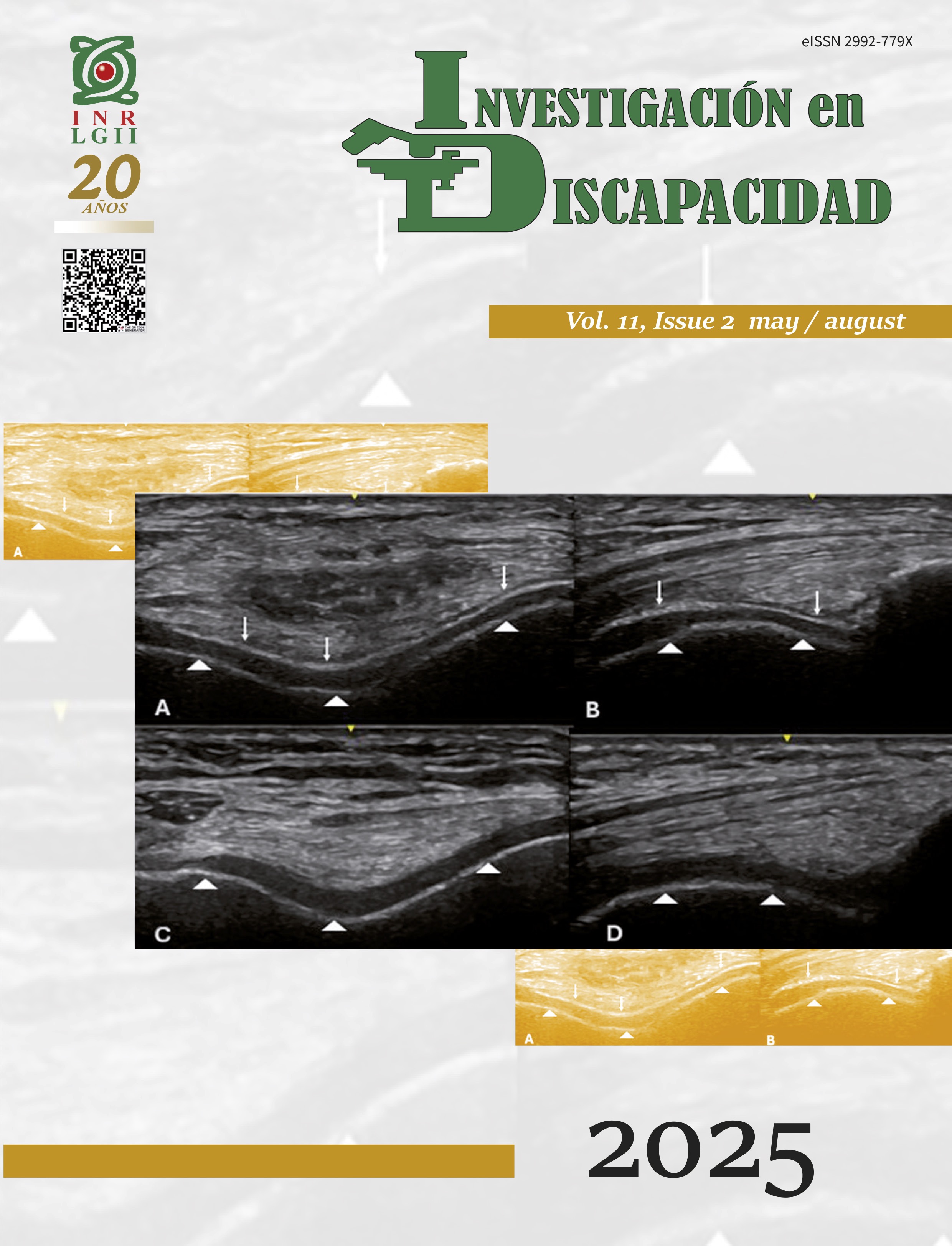Demographic aspects of patients with Parkinson's disease at the National Rehabilitation Institute "LGII" in Mexico City
DOI:
https://doi.org/10.35366/121455Keywords:
Enfermedad de Parkinson, Población Hospitalaria, frecuencia, Estudio epidemiológico.Abstract
Introduction: Parkinson's disease (PD) is a highly disabling health problem is clinically characterized by tremor at rest, bradykinesia, muscle stiffness and postural instability. Objective: To analyze the demographic characteristics of PD patients at the National Institute of Rehabilitation-Luis Guillermo Ibarra Ibarra (INR-LGII) of Mexico City (CDMX) to better understand the disease. Patients and methods: The records of first-time patients with a diagnosis of PD who were seen in the Neurology Service of the INR-LGII were reviewed. Sociodemographic information and medical histories were obtained through the Automated Hospital Information System (SAIH). A database was created, and statistical analysis was performed with the SPSS V17 program. Results: The records of 289 patients with a clinical diagnosis of PD were analyzed. The average age was 73.42 ± 11.34 years (range, 34-103), with 118 (40.8%) men and 171 (59.2%) women. Most of the patients were from Mexico City (51.9%), followed by the State of Mexico (16.6%) and other states (31.5%). Regarding personal habits such as alcohol consumption and smoking, the frequency was negative. Conclusions: The number of patients with PD treated in the INR-LGII is sufficient for additional studies and research that can help design new preventive strategies and increase the coverage of care to combat this public health problem.
Publication Facts
Reviewer profiles N/A
Author statements
Indexed in
- Academic society
- N/A
References
- Postuma RB., Gagnon JF., Montplaisir J. Clinical prediction of Parkinson´s disease: planning for the ge of neuroprotection. J. Neurol Neurosurg Psychiatry 2010; 8(9):1008-13.
- Simon DK., Tanner CM., Brundin P. Parkinson disease epidemiology, pathology, genetics and pathophysiology. Clin Geriatr Med 2020; 36(1): 1-12.
- Dorsey ER., Sherer T., Okun MS., and Bloem BR. The emerging evidence of the Parkinson pandemic. J. Parkinsons Dis 2018; 8(s1): S3-S8.
- GBD 2016 Parkinson´s disease collaborators. Global, regional and national burden of Parkinson´s disease, 1990-2016: a systematic analysis for the global burden of disease study 2016. Lancet Neurol 2018;17(11):939-955.
- Rocca WA. The burden of Parkinson´s disease: a worldwide perspective. Lancet Neurol 2018; 17(11);928-929.
- Pringsheim T., Jette N., Frolkis A., Steeves TD. The prevalence of Parkinson´s disease: a systematic review and meta-analysis. Mov Disord 2014; 29(13):1583-1590.
- De Lau LM., Breteler MM. Epidemiology of Parkinson’s disease. Lancet Neurol 2006; 5(6):525-535.
- Antony PM., Diederich NJ., Krüger R., Balling R. The hallmarks of Parkinson’s disease. FEBS J 2013; 280:5981-5993.
- Tysnes OB., Storstein A. Epidemiology of Parkinson´s disease. J Neural Transm 2017; 124(8):901-905.
- Balestrino R., Schapira AHV. Parkinson´sdisease. Eur J Neurol 2020; 27(1):27-42.
- Rodriguez-Violante M., Villar-Velarde A., Valencia-Ramos C., Cervantes-Arriaga A. Características epidemiológicas de pacientes con enfermedad de Parkinson de un hospital de referencia en México. Arch Neurocien 2011; 16(2): 64-68.
- Cervantes-Arriaga A., Rodriguez-Violante M., López-Ruíz M., Estrada-Bellmann I., Zuñiga-Ramírez C., Otero-Cerdeira E y cols. Caracterización de la enfermedad de Parkinson en México: Estudio ReMePark. Gac Med Mex 2013; 149: 497-501.
- Gillies GE., Pienaar IS., Vohra S., Qamhawi Z. Sex differences in Parkinson’s disease. Front Neuroenddocrinol 2014; 35(3): 370-384.
- Cerri S., Mus L., Blandini.F. Parkinson´s disease in women and Men: what´s the difference? J Parkinsons Dis 2019; 9(3):501-515.
- Vaidya B., Dhamija K., Guru P., Sharma SS. Parkinson´s disease in women: Mechanisms underlying sex differences. Eur J Pharmacol 2021; 895: 173862.
- Rodriguez M., Rodriguez-Sabate C., Morales I., Sanchez A., and Sabate M. Parkinson’s dissease as a result of aging. Aging Cell 2015; 14:293-308.
- Abdullah R., Basak I., Patil KS., Alves G., Larsen JP., Moller SG. Parkinson’s disease and age: the obvious but largely un explored link. Exp Gerentol 2015; 68: 33-38.
- Calabrese V., Santoro A., Monti D., Crupi R., Di Paola R., Latteri S and et al. Aging and Parkinson’s disease: inflammaging, neuroinflammation and biological remodeling as key factors in pathogenesis. Free Radic Biol Med 2018; 115: 80-91.
- Reeve A., Simcox E., Turnbull D. Ageing and Parkinson’s disease: why is advancing age the biggest risk factor. Ageing Res Rev 2014; 14: 19-30.
- Gabbert C., Konig IR., Luth T., Kolms B., Kasten M., Vollsted EJ., et al. Coffe, smoking and aspirin are associated with age at onset in idiopathic Parkinson´s disease. J Neurol 2022;269(8): 4195-4203.
- Quik M., Perez XA., Bordia T. Nicotine as a potential neuroprotector agente for Parkinson’s disease. Mov Disord 2012; 27(8): 947-957.
- Gu Q., Liu X., Zeng Q., Guan X., Zhou C., Guo T. et al. The protective role of cigarette smoking against Parkinson´s disease via moderation of the interaction between iron deposition in the nigrostriatal pathway and clinical symptomas. Quant Imaging Med Surg 2022; 12(7): 3603-3624.
- Bettiol SS., Rose TC., Hughes CJ., Smith LA. Alcohol consumption and Parkinson’s disease risk: A review of recent findings. J Parkinsons Dis 2015; 5(3):425-442.
- Liu R., Guo X., Park Y., Wang J., Huang X., Hollenbeck A., et al. Alcohol consumption, types of alcohol and Parkinson’s disease. PLos One 2013; 8(6):1-7.
- Fukushima W., Miyake Y., Tanaka K., Sasaki S., Kiyohara C., Tsuboi Y., et al. Alcohol drinking and risk of Parkinson’s disease: a case-control study in Japan. BMC Neurology 2010; 10: 1-9.
- Palacios N., Gao X., O’Reilly EJ., Schwarzschild MA., McCullough ML., Mayo T., et al. Alcohol and risk of Parkinson’s disease in a large prospective cohort of men and women. Mov Disord 2012; 27(8):980-987.
Downloads
Published
How to Cite
Issue
Section
License
Copyright (c) 2025 Instituto Nacional de Rehabilitación Luis Guillermo Ibarra Ibarra

This work is licensed under a Creative Commons Attribution 4.0 International License.
© Instituto Nacional de Rehabilitación Luis Guillermo Ibarra Ibarra under a Creative Commons Attribution 4.0 International (CC BY 4.0) license which allows to reproduce and modify the content if appropiate recognition to the original source is given.




